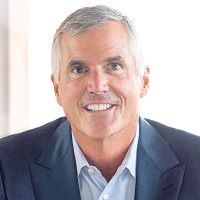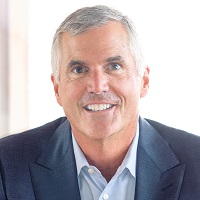Volatility Doesn’t Have to Spell Retirement Planning Trouble
Inflation, rising rates and market gyrations can actually make this a good time to clarify your vision for the future and ensure your portfolio matches those goals and protects against risk.


The past year has given investors plenty of reasons to worry about their retirement savings. While fear is an understandable response to the perfect storm of inflation, rising interest rates, bank failures and market volatility, current economic conditions also provide an opportunity for people to step back and ensure they are well-positioned for the future.
Retirement planning is more complex than most people realize, which is why long-term preparation is critical. Yet many people I talk to spend weeks planning vacations but don’t spend more than an hour or two each month thinking about retirement — if they think about it at all.
When the economic environment is constantly shifting, it’s easy for investors to make reactive decisions based on daily ups and downs. However, these short-term decisions can have long-lasting effects that work against a person’s overall financial goals.
From just $107.88 $24.99 for Kiplinger Personal Finance
Become a smarter, better informed investor. Subscribe from just $107.88 $24.99, plus get up to 4 Special Issues

Sign up for Kiplinger’s Free Newsletters
Profit and prosper with the best of expert advice on investing, taxes, retirement, personal finance and more - straight to your e-mail.
Profit and prosper with the best of expert advice - straight to your e-mail.
F&G’s third annual Risk Tolerance Tracker, which surveyed nearly 1,700 American investors, found that 73% are worried about their retirement income compared to the past two years — 61% in 2021 and 60% in 2020. Of the top concerns, 79% of respondents are worried about inflation impacting their retirement, a sentiment that has continued to increase since 2021, when 73% of respondents said the same.
So, what are investors doing? Nearly half (48%) say they are taking action and actively adjusting their retirement plans. This is good news. A solid, well-thought-out plan makes it easier to put emotion aside. But before making any changes, people should first reassess what retirement means to them.
What Does Retirement Look Like for Me?
One of the first questions financial advisers tend to be asked is, “How much do I need to save for retirement?” It’s a question that is impossible to answer without a deep dive into a person’s lifestyle and vision for the future. For example, does the person need to support adult children or elderly parents? How long do people in their family tend to live? Do they have health issues? Is it important for them to leave money for the next generation, or do they plan to spend most or all of what they have?
All of these things will have a large impact on a person’s “retirement number.”
Does My Portfolio Match My Goals?
Once a person has a vision of what retirement will look like, they should evaluate their portfolio — ideally with a financial adviser — to ensure they have the right products to help them get there. Some may be leaving themselves exposed by taking on too much risk, while others may not be taking enough risk to generate the returns they need.
Often, people say one thing about their risk tolerance and do another. Our survey found that 78% of American investors say they have become more financially risk averse — up from 69% in 2021. Despite this, many investors are relying on volatile investment vehicles such as stocks (41%), with some branching into riskier assets like cryptocurrency (20%).
As people get closer to retirement, their risk tolerance understandably declines. At that stage of life, the risk of a big loss isn’t worth a few extra percentage points of return. Where life insurance can provide peace of mind by ensuring that one’s family is taken care of, eliminating the need for a retiree to worry about if they are spending too much of their children’s inheritance, insurance products like annuities can reduce the level of risk within a retirement portfolio.
Many annuities are protected from market downturns, serve as a hedge against inflation and can come with a duration that matches one’s life expectancy, reducing longevity risk. Annuities can provide a different sort of guarantee — a stream of guaranteed income. As with life insurance, annuities can remove anxiety over spending, as people know they will be getting a check every month for as long as they live.
Despite the benefits these types of products can provide, only 14% of Americans report owning one, underscoring how many investors are not taking advantage of the full range of options available to address these types of inflation or longevity concerns.
How Do I Create a Holistic Plan?
Of course, creating a personalized portfolio is easier said than done. As investors look at products to purchase, they must analyze the pros and cons of each one, as well as how they work together in a diversified plan.
As mentioned, insured products can help create a more holistic plan alongside traditional investments, and speaking with a financial adviser can help simplify the process. While 45% of American investors say they are willing to explore new financial products, a majority (58%) are not leveraging the skills of an adviser to create a strong portfolio.
By clarifying their vision for the future, exploring an expanded universe of financial products and connecting with an adviser, investors can ensure their portfolios are built to optimize opportunities and protect their downside risk. While the current financial environment can be scary, stepping back from the day-to-day to plan for the long term can help people stay focused on the big picture and sleep better at night.
Profit and prosper with the best of Kiplinger's advice on investing, taxes, retirement, personal finance and much more. Delivered daily. Enter your email in the box and click Sign Me Up.

For more than 30 years, Chris Blunt has held senior leadership positions at several major insurance and financial services companies. He joined F&G in 2019 and currently serves as the Chief Executive Officer. Prior to that, he served as Chief Executive Officer at Blackstone Insurance Solutions and spent nearly 13 years at New York Life in a variety of executive roles.
-
 Your Guide to Buying Art Online
Your Guide to Buying Art OnlineFrom virtual galleries to social media platforms, the internet offers plenty of places to shop for paintings, sculptures and other artwork without breaking the bank.
-
 Samsung Galaxy S25 Ultra for $4.99 a Month: A Closer Look at Verizon’s Deal
Samsung Galaxy S25 Ultra for $4.99 a Month: A Closer Look at Verizon’s DealVerizon’s aggressive pricing makes Samsung’s top-tier phone tempting, but the real cost depends on your plan and how long you stay.
-
 I'm 59 with $1.7 million saved and lost my job. Should I retire?
I'm 59 with $1.7 million saved and lost my job. Should I retire?We asked professional wealth planners for advice.
-
 A Wealth Adviser Explains: 4 Times I'd Give the Green Light for a Roth Conversion (and 4 Times I'd Say It's a No-Go)
A Wealth Adviser Explains: 4 Times I'd Give the Green Light for a Roth Conversion (and 4 Times I'd Say It's a No-Go)Roth conversions should never be done on a whim — they're a product of careful timing and long-term tax considerations. So how can you tell whether to go ahead?
-
 A 4-Step Anxiety-Reducing Retirement Road Map, From a Financial Adviser
A 4-Step Anxiety-Reducing Retirement Road Map, From a Financial AdviserThis helpful process covers everything from assessing your current finances and risks to implementing and managing your personalized retirement income plan.
-
 The $183,000 RMD Shock: Why Roth Conversions in Your 70s Can Be Risky
The $183,000 RMD Shock: Why Roth Conversions in Your 70s Can Be RiskyConverting retirement funds to a Roth is a smart strategy for many, but the older you are, the less time you have to recover the tax bite from the conversion.
-
 A Financial Pro Breaks Retirement Planning Into 5 Manageable Pieces
A Financial Pro Breaks Retirement Planning Into 5 Manageable PiecesThis retirement plan focuses on five key areas — income generation, tax management, asset withdrawals, planning for big expenses and health care, and legacy.
-
 4 Financial To-Dos to Finish 2025 Strong and Start 2026 on Solid Ground
4 Financial To-Dos to Finish 2025 Strong and Start 2026 on Solid GroundDon't overlook these important year-end check-ins. Missed opportunities and avoidable mistakes could end up costing you if you're not paying attention.
-
 Are You Putting Yourself Last? The Cost Could Be Your Retirement Security
Are You Putting Yourself Last? The Cost Could Be Your Retirement SecurityIf you're part of the sandwich generation, it's critical that you don't let the needs of your aging parents come at the expense of your future.
-
 I'm an Insurance Pro: It's Time to Prepare for Natural Disasters Like They Could Happen to You
I'm an Insurance Pro: It's Time to Prepare for Natural Disasters Like They Could Happen to YouYou can no longer have the mindset that "that won't happen here." Because it absolutely could. As we head into 2026, consider making a disaster plan.
-
 The Future of Philanthropy Is Female: How Women Will Lead a New Era in Charitable Giving
The Future of Philanthropy Is Female: How Women Will Lead a New Era in Charitable GivingWomen will soon be in charge of trillions in charitable capital, through divorce, inheritance and their own investments. Here's how to use your share for good.